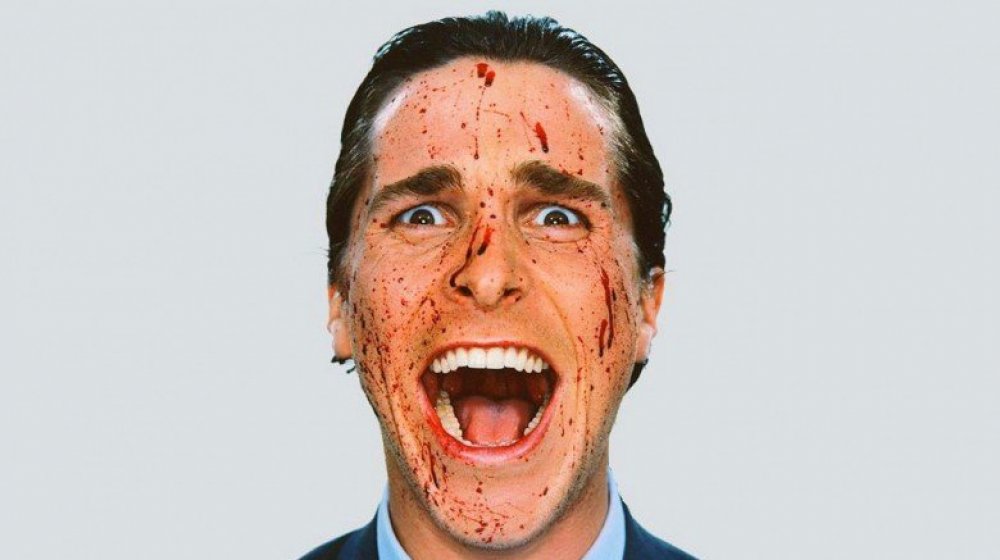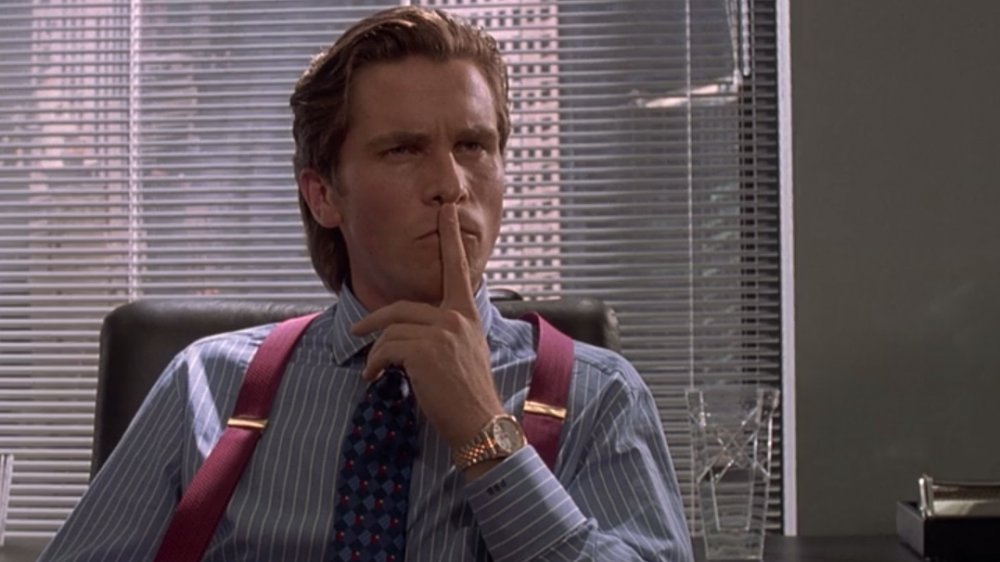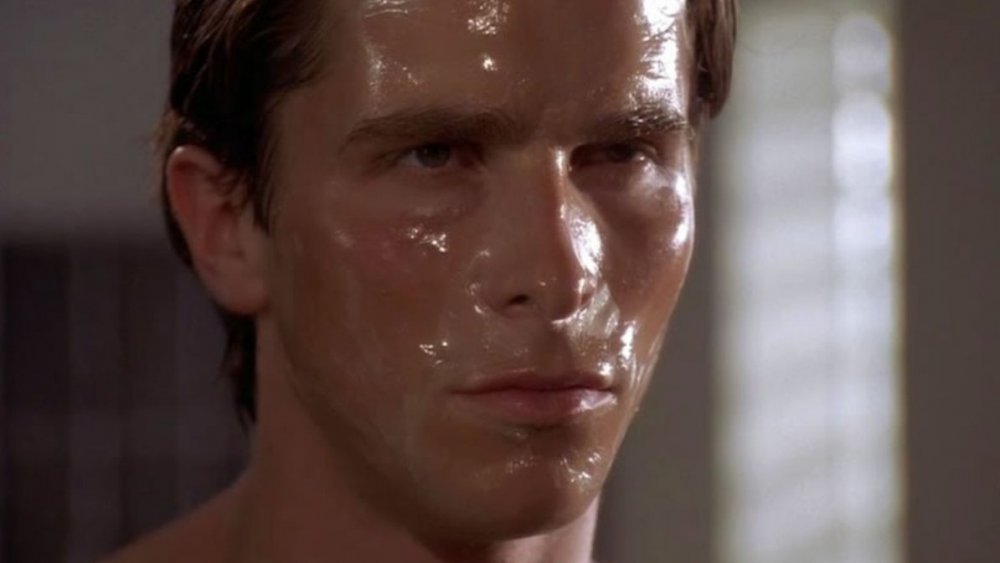American Psycho Writers Break Down The Film's Bizarre Ending
Whether in the real world or in the "dream factory" of Hollywood, 20th anniversaries of any sort tend to be a very big deal. As the year 2000 was a particularly strong one in the world of cinema, 2020 will certainly see its share of exposés and interviews about some of the year's more memorable offerings. One of the biggest movies from 2000 is also one of its most divisive: the hyper-violent, Christian Bale-starring, satirical psychological horror American Psycho.
Adapted from Bret Easton Ellis' novel with a devilishly satirical edge by director Mary Harron, American Psycho is set in the male-centric financial world of 1980s New York, and follows Bale's yuppie bad boy Patrick Bateman as he descends into a bloody world of murder and mayhem the likes of which many viewers weren't fully prepared for. As American Psycho's blood-drenched narrative unfolds, the mayhem becomes increasingly brutal to the point of nearly cartoonish. That's sort of the point, though, as Bateman's mental state throughout is very much in question.
American Psycho closes out its maddening tale of toxic masculine excess with a deviously ambiguous ending that's had fans scratching their heads for two decades now. It's never been clear whether Patrick Bateman actually committed all the unfathomably heinous acts he openly confesses to in the film's perplexing final moments.
It seems 20 years of speculation was enough for American Psycho's co-writers, Harron and Guinevere Turner (who also portrayed Elizabeth in the film). The two recently spoke to MovieMaker Magazine about the film's ending as part of a 20th anniversary American Psycho retrospective, and it seems the answer to whether or not Bateman really did kill "a lot of people" is a fairly definitive "yes" — but with a definite side of "not exactly."
Intentional ambiguity in American Psycho
That answer may leave folks a bit frustrated, as it seems Turner and Harron are still playing coy about American Psycho's infamous late-in-the-game rug pulling. Initially, that's just what happens: Harron refuses to answer whether Bateman's murders were real or imagined outright by stating bluntly, "I would never answer that." Thankfully, the director and American Psycho co-writer went on to offer a more straightforward reading of a moment in the film that should prove revelatory in regards to everything that comes after: "I will say there's a moment where it becomes less realistic, and that's the moment when the ATM says 'Feed me a stray cat.'"
By this point in the film, Harron and Turner had playfully taken to blurring the lines between what was real and what was fantasy when it came to Bateman's violent outbursts; his world got even more surreal after that ATM incident. Per Harron's statement, we can now infer that was intentional — which means everything that came after can now be viewed with at least a tinge of psychotic embellishment, if not seen as an outright hallucination.
Later in the interview, Turner explained that the ending of American Psycho was supposed to be ambiguous, noting that she and Harron find it "annoying" when a movie's "big reveal is that it was all in someone's head or it was all a dream."
"To me and Mary, the book left it up in the air, too, what was real and what was not real. We didn't think that everything was real because some of it is literally surreal," she stated. "We just said we're going to make a really conscious effort to have it be real, and then at some point... he's sort of perceiving things differently, but they're really happening."
Turner further expounded on her and Harron's approach to the film (particularly its ending) by looking to another over-the-top moment in American Psycho: "Like he shoots at a cop car, and it just bursts into flames, and she just directed him to look at the gun like, 'Hmmm, how did that happen?'"
Patrick Bateman's violently psychotic behavior in American Psycho wasn't just in his head
If there's one mammoth takeaway here, it's Turner's assertion that there was "a really conscious effort to have it be real." That bit of info is important because Bateman has already spilled a fair amount of blood before he begins "perceiving things differently." It also implies that though the character is apparently seeing and even experiencing things in surreal fashion after an assumed psychotic break, those things are probably still happening.
This is hardly the first time the American Psycho team has sought to expose the film's ending. In a 2000 interview with Charlie Rose, both Harron and star Christian Bale confirmed that Bateman hadn't simply imagined all the American Psycho bloodletting. Bale offered bluntly, "Bateman does actually have an arc in the movie. He goes from psychopath to psychotic."
Harron was far more concise about American Psycho's final moments — actually putting blame for some of the ambiguity on her own shoulders: "One thing I think is a failure on my part is everyone keeps coming out of the film thinking that it's all a dream, and I never intended that ... I think it's a failing of mine in the final scene that I just got the emphasis wrong, because I should have left it more open-ended ... It makes it look like it was all in his head, and as far as I'm concerned, it's not."
As echoed by Turner to Movie Maker Magazine, that "it's not" is about as clear an indication you'll get that Bateman absolutely has a few gallons of blood on his hands at the end of American Psycho. We can only assume, however, that his body count isn't quite as high as he claims — and that he maybe didn't pull off that insane chainsaw kill in quite such dramatic fashion.


